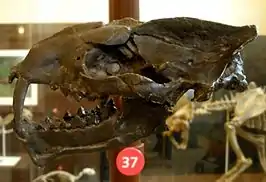Machaeroides
Machaeroides ("dagger-like") is an extinct genus of sabre-toothed predatory placental mammals from extinct subfamily Machaeroidinae within extinct family Oxyaenidae, that lived in North America (Wyoming) from the early to middle Eocene.
| Machaeroides Temporal range: early to middle Eocene | |
|---|---|
 | |
| Machaeroides eothen skull | |
 | |
| Machaeroides eothen restoration | |
| Scientific classification | |
| Domain: | Eukaryota |
| Kingdom: | Animalia |
| Phylum: | Chordata |
| Class: | Mammalia |
| Clade: | Pan-Carnivora |
| Order: | †Oxyaenodonta |
| Family: | †Oxyaenidae |
| Subfamily: | †Machaeroidinae |
| Genus: | †Machaeroides Matthew, 1909 |
| Type species | |
| †Machaeroides eothen Matthew, 1909 | |
| Species | |
 | |
| A map showing the fossil finds of Machaeroides as well as other machaeroidinid genera. | |
Description
Both species bore a passing or superficial resemblance to a very small, dog-sized saber-toothed cat. Machaeroides could be distinguished from actual saber-toothed cats by their more-elongated skulls, and their plantigrade stance. Machaeroides species are distinguished from the closely related Apataelurus by the fact that the former genus had smaller saber-teeth. Despite its small size, the genus Machairoides was well-equipped to hunt prey larger than itself, such as the small, primitive horses and rhinoceroses present at the time, as it was equipped with saber teeth and powerful forelimbs to subdue prey.[3]
M. eothen weighed an estimated 10–14 kg (22–31 lb), thus matching in size a small Staffordshire Terrier. M. simpsoni was probably smaller.[4]
Taxonomic placement
Its position within the mammals has been in dispute. Experts have been equally divided over whether Machaeroides and its sister-genus, Apataelurus, belong in Oxyaenidae or Hyaenodonta, though as of 2014 the most recent studies favor the former.[5]
Phylogeny
The phylogenetic relationships of the genus Machaeroides are shown in the following cladogram.[6][7][8][9]
| Pan-Carnivora |
| |||||||||||||||||||||||||||||||||||||||||||||||||||||||||||||||||||||||||||||||||||||
See also
References
- W. D. Matthew. (1909.) "The Carnivora and Insectivora of the Bridger Basin, middle Eocene." Memoirs of the American Museum of Natural History 9:289-567
- M. R. Dawson, R. K. Stucky, L. Krishtalka and C. C. Black. (1986.) "Machaeroides simpsoni, new species, oldest known sabertooth creodont (Mammalia), of the Lost Cabin Eocene." Contributions to Geology, University of Wyoming, Special Paper 3:177-182
- Antón, Mauricio (2013). Sabertooth. Indiana University Press. ISBN 978-0-253-01049-0.
- Egi, Naoko1 (2001). "Body Mass Estimates in Extinct Mammals from Limb Bone Dimensions: the Case of North American Hyaenodontids". Palaeontology. 44 (3): 497–528. doi:10.1111/1475-4983.00189.
- Zack, S. (2014). "Saber-tooth origins: a new skeletal association and the affinities of Machaeroidinae (Mammalia, Creodonta)". Journal of Vertebrate Paleontology, Program and Abstracts: 259–260.
- Gunnel, Gregg F.; Gingerich, Philip D. (1991). "Systematics and evolution of late Paleocene and early Eocene Oxyaenidae (Mammalia, Creodonta) in the Clarks Fork Basin, Wyoming" (PDF). Contributions from the Museum of Paleontology. The University of Michigan. 28 (7): 141–180.
- Solé, Floréal; Ladevèze, Sandrine (2017). "Evolution of the hypercarnivorous dentition in mammals (Metatheria,Eutheria) and its bearing on the development of tribosphenic molars". Evolution & Development. 19 (2): 56–68. doi:10.1111/ede.12219. PMID 28181377. S2CID 46774007.
- Prevosti, F. J. & Forasiepi, A. M. (2018.) "Introduction. Evolution of South American Mammalian Predators During the Cenozoic: Paleobiogeographic and Paleoenvironmental Contingencies"
- Shawn P. Zack (2019). "A skeleton of a Uintan machaeroidine 'creodont' and the phylogeny of carnivorous eutherian mammals". Journal of Systematic Palaeontology. 17 (8): 653–689. doi:10.1080/14772019.2018.1466374. S2CID 89934728.